Packrafting Canada’s Nahanni River
9-minute read
In the summer of 2023, Aqua Bound Ambassador Jeremie Lamart joined a crew to packraft Canada’s Nahanni River over 10 days. This remote national park in The Northwest Territories offers stunning scenery, abundant wildlife and in this case, a chance to meet new friends while outdoor adventuring.

Packrafting through one of several canyons on Canada’s Nahanni River
Jeremie was happy to provide us with stories of his experience along with a few of his photos and original drawings:
AQUA BOUND: What was your impression of Nahanni National Park and the NW Territories in general?
JEREMIE: Canada is an enormous country. You can drive in a straight line for days. The NW Territories made a big impression on me as soon as we crossed its border, leaving British Columbia behind us—as well as the asphalt on the road.
My very first impression of the NWT was that I had just stepped into a National Geographic special—a gravel road instead of a highway, bison napping on the side of the road, bears walking around minding their own business, no 7-Eleven (and no Timmie's either for that matter). A real sense of adventure.
And then comes Nahanni, a national park the size of Belgium. If you didn't know, Belgium is a country. A country with roads, full-sized houses, good beer and pretty decent people. Nahanni NP has none of these (except for a few very nice people) but has something Belgium lacks big-time: wilderness.
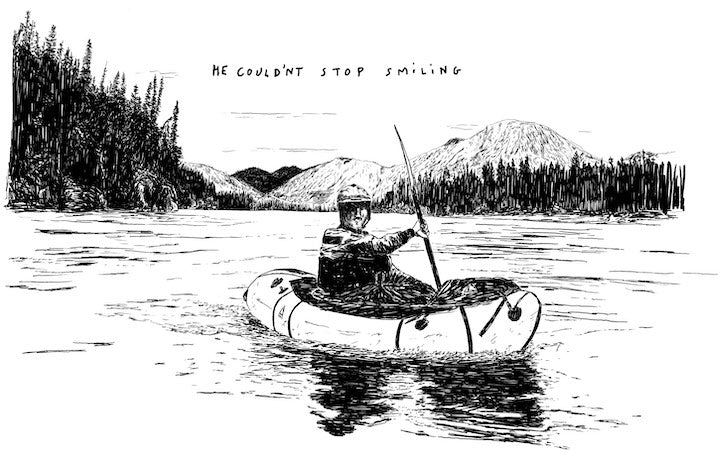
Nahanni National Park has big canyons, snow-capped mountains, endless forests and one massive river, the Nahanni, the park’s namesake. I sensed a balance between human presence and nature, a seemingly ideal human-nature ratio that doesn't exist in many places in the world. The First Nations culture is still strong in the NWT. The Dene have a rich and interesting history and I loved learning about it.
Then there's the Nahanni River with its four majestic canyons. It’s definitely one of the most beautiful rivers I’ve had the chance to paddle. The views are breathtaking and the rapids are fun. Most of the river has fast-moving water, so even if you don't paddle much you can cover a lot of distance in a day.
South Nahanni starts just under Virginia Falls (twice the height of Niagara Falls) and flows through very diverse types of landscapes. Every day is different. It feels that there's potential for more than a lifetime of exploration in the region. Words can’t do justice to its beauty.
AB: What was it like taking inexperienced paddlers there? Are there any special precautions needed for a trip like this?
JEREMIE: I was invited on the trip by my friend Hannes who is a wilderness guide. Hannes had gathered a group of five of his friends to achieve this trip he had been dreaming about for decades. I felt honoured to be invited to join them.
As a seasoned whitewater kayaker and packrafting guide and instructor, I knew I would be helping a lot of my teammates who were not very experienced packrafters. South Nahanni isn’t technically hard, but nevertheless, it’s a massive and remote river with rapids up to Class 3 big water (big fun waves). A multi-day packrafting expedition in these conditions should not be taken lightly. It’s important to acknowledge that this river is NOT suitable for a group of only beginners.

Some crazy clouds in the sky overhead
As the most experienced paddler in the group, I had to make sure we would work well as a team on the river. The danger when you take beginners is they think their safety is only in your hands. That is true to a certain point only. It was crucial for me to create a dynamic within the group so everybody looked out for each other and developed good habits. South Nahanni is a perfect river to work on these skills because of its mellow technical difficulty.

Two of the group members
There are a few mandatory rules to follow when travelling in a group. These are easy to apply on any kind of wilderness trip. Every group needs:
- To have a good system of communication within the group. On the river, we used the international river signals.
- To always keep someone from the group in sight—to never lose visual contact with at least one other person from the group.
- To be aware of the dangers or consequences of their activities and to anticipate a plan before something happens.
- To always scan their surroundings and make sure they position themselves to be useful in case something happens.
Our group worked very well together. Everyone was keen to learn and took their role seriously. We looked for hazards on the river such as trees, scouted one rapid from shore, and after 10 days on the river, everyone had developed good paddling skills and the ability to work in a team.
AB: Tell us more about how the wilderness creates unique opportunities to form new bonds with strangers.
JEREMIE: I’ve been on trips by myself, with friends, life partners, beginners, proper explorers, et cetera. It's been a different experience every time. Sometimes it was great, sometimes a disaster. But it's always pretty intense.
Various factors alter the way you experience companionship one way or another—the difficulty of the trip, weather conditions, terrain and planning. The human factor is always huge and going on a remote trip with strangers is, of course, committing.
Social standards are different on the river than in the city. Ego, individualism and consumerism are the opposite of proper behaviour during an expedition (and also in the city if you want my humble opinion). In that sense, going on wilderness trips is a way to learn how to behave in society too.
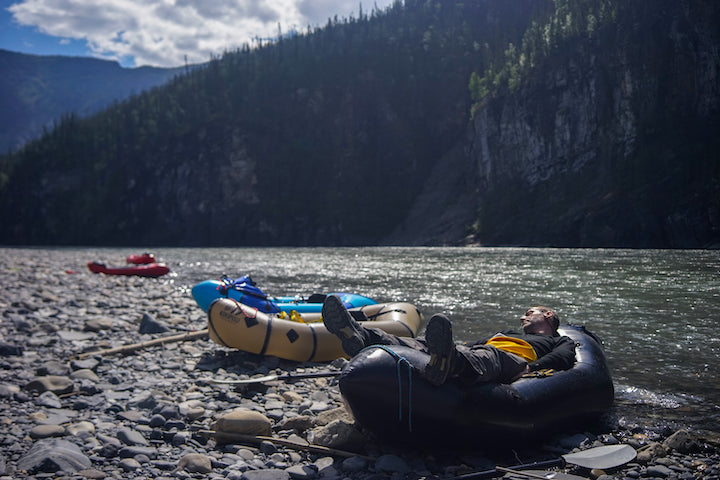
Taking advantage of a break and a soft bed
It’s hard to hide your true self in these situations, so the relationships you create during expeditions are among the most honest ones we can experience. In other words, it's a good way to get to know someone.
Days on the river can be long. Sometimes the flow is so gentle you can allow yourself to just float down, enjoying the views and the company. So you jump from one conversation to another. You get to know these people and understand what brought them where they are. You go from not knowing these people to relying on them to save you if something bad happens.
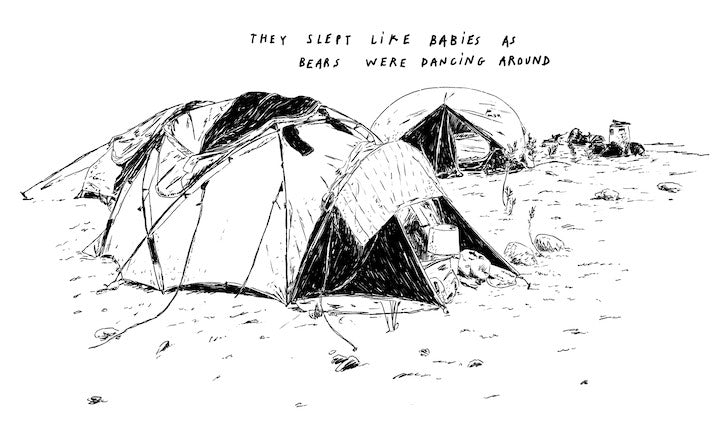
One minute you shake hands at the airport and introduce yourself politely. Then what feels like one minute later, you look out for bears when they go for their number two and joke about it.
From nothing, these people become your only human interaction for a short period of time. Then "normal" life starts again and everyone goes their own way. Was it a dream? In all dreams there are great times and others that are not so great. Just like life in general. So the bonds we all created during this trip were very special and precious.
Dreamer Christopher McCandless wrote that "happiness is only real when shared" before dying alone in the wilderness. Meanwhile, French philosopher Jean-Paul Sartre made himself famous for stating that “hell is other people.”
I'll let you choose your own team, but in the end, I'd say that going on trips with strangers who become your friends in a split second is absolutely fabulous! Only in the backcountry can you experience such things. Huge thanks and hugs to all my teammates Hannes Leroy, Mona, Silian, Stijn and Willem who made it a wonderful human experience.
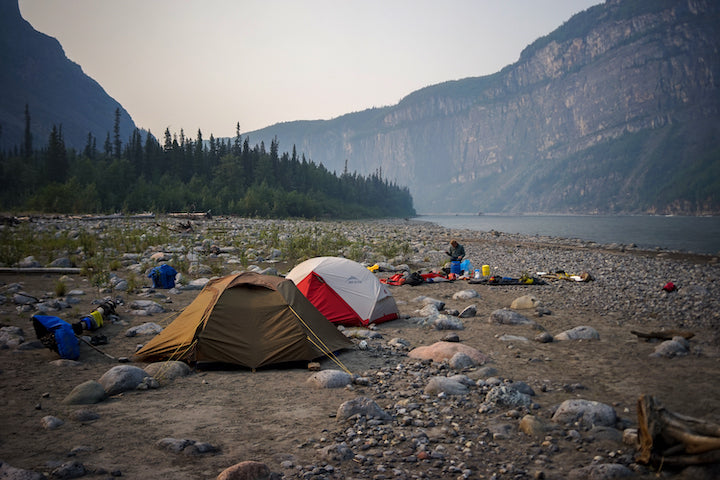
Riverside campsite among huge canyon walls
AB: Other than the destination, did you experience anything new for you on this trip?
JEREMIE: I live in Scandinavia and even if we have one of the largest populations of brown bears in Europe, we almost never see them. They came to avoid all interactions with humans long ago because we've been hunting them for thousands of years.
Traveling in “real” bear country was a first for me on this trip. I was equally excited and scared about it. Some people love funny and cute cat videos on the internet, my Instagram feed is full of bears.
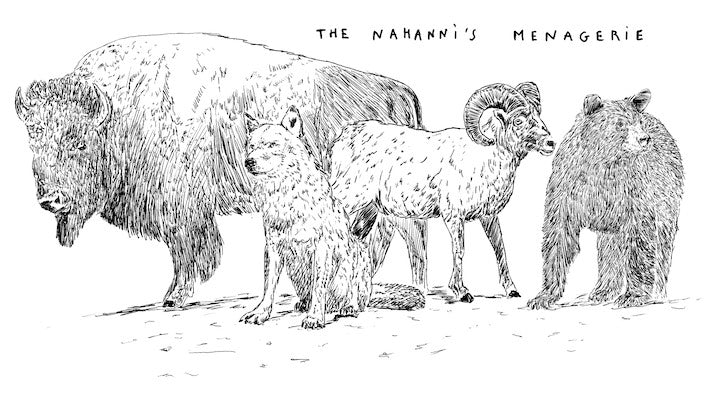
It was my first time carrying bear spray, looking for bear activity around camp and storing food in bear-proof bags. I can't say I wasn't a bit nervous the first night, but then everything became part of a safety routine.
We spotted incredible wildlife during this trip—bighorn, bison, black bears, one grizzly and we were even blessed to have a whole pack of wolves running on the shore next to us as we paddled.
AB: Tell us about your trip logistics.
JEREMIE: Logistics can be a bit complicated when you travel in such a remote place. Getting to the river was a small expedition by itself. We drove from Vancouver to Fort Simpson, about 1,250 miles. Then we took a float plane that took us just above Virginia Falls in the heart of the National Park. It's a 1.5-hour flight and it can be a pretty bumpy ride in these small planes.

We didn't need an outfitter for this trip, we did all the paperwork to get a river permit ourselves, used our own equipment and made it down the river on our own. It took a bit of thinking to organise everything but it’s not impossible!
In terms of gear, I was paddling my trustworthy 7-year-old Alpacka Raft Alpackalypse (a retired model). I’ve used this boat around the world from Nepal to the Grand Canyon. It’s all patched up and I love it.
Two other pieces of gear I loved for this trip were my Immersion Research drysuit (water is always cold on Nahanni) and my Bedrock Sandals which are perfect camp and river shoes. But the one item that I could not have done without was my mosquito net—the bugs were terrible in places!
AB: Which Aqua Bound paddles did you use?
JEREMIE: Aqua Bound was the number one brand on this trip with a selection of classic packrafting models. The Shred Apart split for the two-person boat (an Alpacka Raft Forager). There was a Shred Carbon and a few of us used the Manta Ray—a perfect choice for this section of the river as you have more relaxed paddling most of the time.
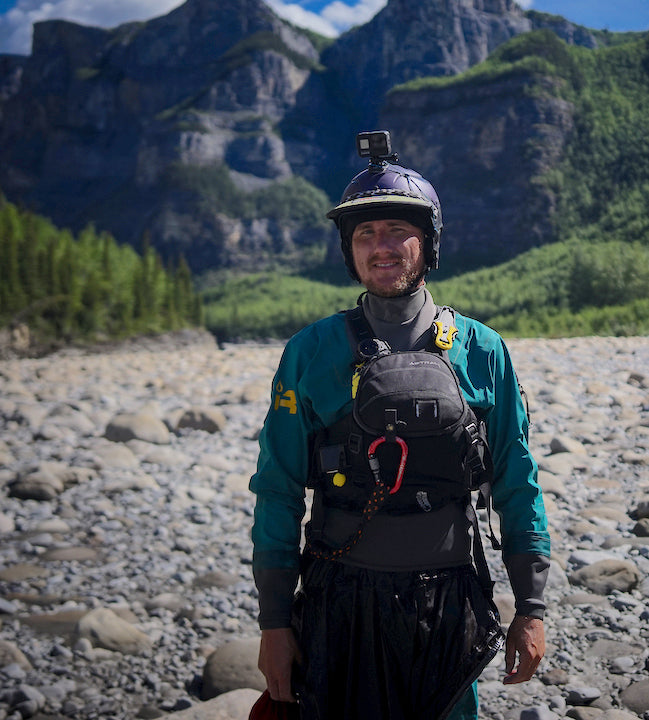
All photos and illustrations courtesy of Jeremie Lamart.
Do you have paddle questions our friendly Customer Service Team can help you with today? Contact them: 715-755-3405 • sales@aquabound.com
More for you...





